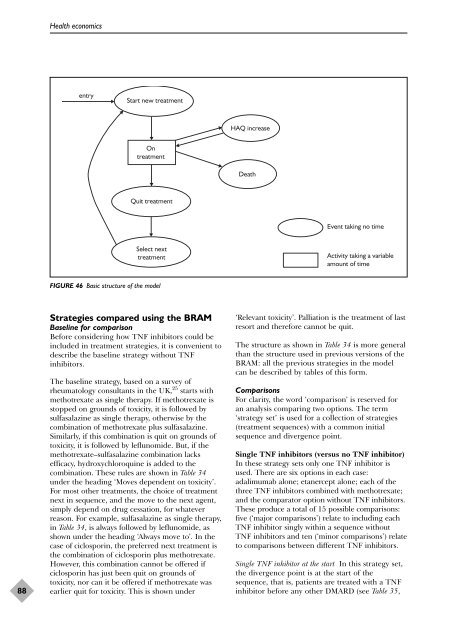A systematic review of the effectiveness of adalimumab
A systematic review of the effectiveness of adalimumab
A systematic review of the effectiveness of adalimumab
Create successful ePaper yourself
Turn your PDF publications into a flip-book with our unique Google optimized e-Paper software.
88<br />
Health economics<br />
entry<br />
Start new treatment<br />
On<br />
treatment<br />
Quit treatment<br />
Select next<br />
treatment<br />
FIGURE 46 Basic structure <strong>of</strong> <strong>the</strong> model<br />
Strategies compared using <strong>the</strong> BRAM<br />
Baseline for comparison<br />
Before considering how TNF inhibitors could be<br />
included in treatment strategies, it is convenient to<br />
describe <strong>the</strong> baseline strategy without TNF<br />
inhibitors.<br />
The baseline strategy, based on a survey <strong>of</strong><br />
rheumatology consultants in <strong>the</strong> UK, 25 starts with<br />
methotrexate as single <strong>the</strong>rapy. If methotrexate is<br />
stopped on grounds <strong>of</strong> toxicity, it is followed by<br />
sulfasalazine as single <strong>the</strong>rapy, o<strong>the</strong>rwise by <strong>the</strong><br />
combination <strong>of</strong> methotrexate plus sulfasalazine.<br />
Similarly, if this combination is quit on grounds <strong>of</strong><br />
toxicity, it is followed by leflunomide. But, if <strong>the</strong><br />
methotrexate–sulfasalazine combination lacks<br />
efficacy, hydroxychloroquine is added to <strong>the</strong><br />
combination. These rules are shown in Table 34<br />
under <strong>the</strong> heading ‘Moves dependent on toxicity’.<br />
For most o<strong>the</strong>r treatments, <strong>the</strong> choice <strong>of</strong> treatment<br />
next in sequence, and <strong>the</strong> move to <strong>the</strong> next agent,<br />
simply depend on drug cessation, for whatever<br />
reason. For example, sulfasalazine as single <strong>the</strong>rapy,<br />
in Table 34, is always followed by leflunomide, as<br />
shown under <strong>the</strong> heading ‘Always move to’. In <strong>the</strong><br />
case <strong>of</strong> ciclosporin, <strong>the</strong> preferred next treatment is<br />
<strong>the</strong> combination <strong>of</strong> ciclosporin plus methotrexate.<br />
However, this combination cannot be <strong>of</strong>fered if<br />
ciclosporin has just been quit on grounds <strong>of</strong><br />
toxicity, nor can it be <strong>of</strong>fered if methotrexate was<br />
earlier quit for toxicity. This is shown under<br />
HAQ increase<br />
Death<br />
Event taking no time<br />
Activity taking a variable<br />
amount <strong>of</strong> time<br />
‘Relevant toxicity’. Palliation is <strong>the</strong> treatment <strong>of</strong> last<br />
resort and <strong>the</strong>refore cannot be quit.<br />
The structure as shown in Table 34 is more general<br />
than <strong>the</strong> structure used in previous versions <strong>of</strong> <strong>the</strong><br />
BRAM: all <strong>the</strong> previous strategies in <strong>the</strong> model<br />
can be described by tables <strong>of</strong> this form.<br />
Comparisons<br />
For clarity, <strong>the</strong> word ‘comparison’ is reserved for<br />
an analysis comparing two options. The term<br />
‘strategy set’ is used for a collection <strong>of</strong> strategies<br />
(treatment sequences) with a common initial<br />
sequence and divergence point.<br />
Single TNF inhibitors (versus no TNF inhibitor)<br />
In <strong>the</strong>se strategy sets only one TNF inhibitor is<br />
used. There are six options in each case:<br />
<strong>adalimumab</strong> alone; etanercept alone; each <strong>of</strong> <strong>the</strong><br />
three TNF inhibitors combined with methotrexate;<br />
and <strong>the</strong> comparator option without TNF inhibitors.<br />
These produce a total <strong>of</strong> 15 possible comparisons:<br />
five (‘major comparisons’) relate to including each<br />
TNF inhibitor singly within a sequence without<br />
TNF inhibitors and ten (‘minor comparisons’) relate<br />
to comparisons between different TNF inhibitors.<br />
Single TNF inhibitor at <strong>the</strong> start In this strategy set,<br />
<strong>the</strong> divergence point is at <strong>the</strong> start <strong>of</strong> <strong>the</strong><br />
sequence, that is, patients are treated with a TNF<br />
inhibitor before any o<strong>the</strong>r DMARD (see Table 35,
















